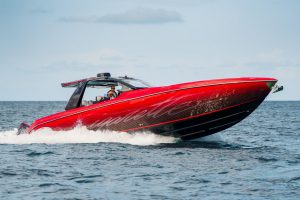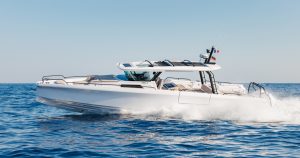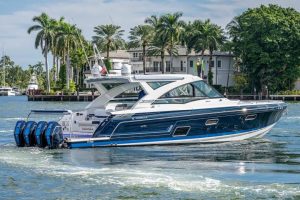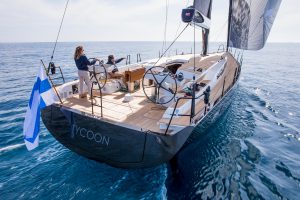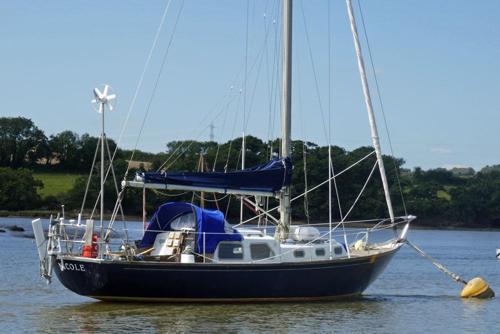Yawl Style Sail Boats: An In-Depth Guide to Their Unique Features
A yawl is a distinct type of sailboat characterized by its two-mast, fore-and-aft rigged design. The main feature that sets yawls apart from other sailboats is the placement of the mizzen mast, which is located aft of the rudder post. This arrangement results in the mizzen sail primarily serving as a balancing point rather than a driving force, with the main sails providing the majority of propulsion.
Yawl sailboats typically have a total sail area ranging from a minimum of 545 square feet to a maximum of 1,510 square feet, averaging around 776 square feet. Although not as common as other sailboat types, such as the Bermuda sloop or ketch, yawls are appreciated for their stability and ease of handling, particularly when it comes to mooring or maneuvering in tight spaces. The smaller mizzen sail contributes to this steadiness, making yawls a popular choice for cruising sailors seeking both performance and comfort.
Various yacht builders and designers have produced yawls over the years, resulting in a diverse range of models and sizes for different preferences and budgets. While they may not be the most prevalent sailboat type on the market, their unique design and practical advantages have earned them a loyal following among sailing enthusiasts.
Yawl vs Ketch
Yawl and Ketch sailboats are two-masted vessels with divided rigs, where the main sail area is divided between the two masts. The taller mast is the main mast, while the shorter mizzen mast is located behind it rightboat.com. The primary difference between a Yawl and a Ketch lies in the placement of the mizzen mast.
In a Yawl sailboat, the mizzenmast is located aft of the rudder post, meaning it is behind the main mast. This mizzen mast is primarily used for creating balance rather than propelling the vessel MarineSource.com. In contrast, a Ketch sailboat has its mizzen mast situated forward of the rudder post, which is closer to the center of the boat DesperateSailors.com.
Yawl rigs generally have smaller mizzens compared to Ketches. However, they still offer several advantages over a single-masted sloop, such as providing more options for sail configurations to suit different sailing conditions boats.com. On the other hand, Ketches have larger mizzens that contribute more to propulsion, and they can be more easily managed when sailing in strong winds TripSavvy.
Both Yawl and Ketch sailboats hold advantages for different types of sailors and situations. While Yawls provide better balance and versatility in sail configurations, Ketches are popular among more experienced sailors who appreciate the additional propulsion provided by a larger mizzen mast.
Design Features
A yawl sailboat is a two-masted vessel with several unique design characteristics that set it apart from other sailboats. The main mast is higher than the mizzen mast, and the mizzen mast is positioned behind the rudder post (Britannica). These features, combined with rigging and sail arrangements, contribute to the distinctive sailing abilities and versatility of yawl boats.
Yawl boats are typically constructed from wood or fiberglass, which ensures a strong and durable hull capable of withstanding waves and wind while sailing (Daily Boats). The cabin of the yawl is usually located in the stern, providing more space for occupants compared to other sailboat designs.
Regarding sails and rigging, yawls are rigged with fore-and-aft sails (in line with the keel) (Britannica). This setup includes one or more jibsails, a mainsail, and a mizzen sail. The mizzen sail's primary function on a yawl is to aid in steering and balance, providing finer control over the boat's movements.
- Hull Material: Wood or fiberglass
- Masts: Two masts, main mast taller than mizzen mast
- Mizzen Mast Position: Behind the rudder post
- Sails: Fore-and-aft rigged, including jibsails, mainsail, and mizzen sail
- Cabin Location: In the stern
The yawl's distinctive design offers multiple advantages, such as improved maneuverability, easier tacking, and better balance in various wind conditions. These benefits make the yawl a popular choice for both recreational and competitive sailing.
Performance
Yawl-style sailboats are known for their unique performance characteristics in various sailing conditions. A key feature of a yawl is the combination of two masts, with the mizzen mast situated aft of the main mast. This arrangement contributes to the versatility and maneuverability of the boat.
One of the main advantages of a yawl is its ability to maintain steadiness during mooring, thanks to the small sail hanging over the stern. This sail, known as the mizzen sail, serves mainly as a balancing point rather than a driving sail, providing stability and increased control at lower speeds.
Yawls also offer a great deal of flexibility in sail configurations. They can typically carry more canvas than a sloop or a ketch, making them suitable for light wind conditions. Additionally, the presence of two masts allows for more balanced sail plans, which evenly distribute the load on the sails and help with maintaining optimal sailing angles upwind and downwind.
Despite having smaller sail areas compared to some other sailboat types, yawls have proven to be efficient and seaworthy vessels. According to Boat Trader, yawl sailboats can have a total sail area ranging from 545 to 1,510 square feet, with an average of 776 square feet. This size range ensures that yawls are suitable for a variety of sailing conditions and purposes, whether it be leisure cruising or offshore voyages.
Popular Yawl Models
When discussing yawl sailboats, several models have gained popularity over the years due to their exceptional design and performance. One of the most well-known yawl models is the Hinckley Bermuda 40, designed by the prestigious Hinckley Company. This vessel has earned a reputation for both its stunning craftsmanship and sea-worthy performance.
Another notable yawl model is the Holman Rummer Yawl, which originated in the United Kingdom. Known for its aesthetic elegance and durability, this yawl is particularly sought after by sailing enthusiasts.
In addition to these classics, there are several other yawl models worth mentioning:
- Pearson Wanderer 30 - A sleek and versatile yawl designed by the renowned Pearson Yachts.
- Custom Built 50" - A unique and customizable yawl model built by skilled craftsmen to suit individual preferences and sailing requirements.
- William Garden 45 Yawl - Designed by naval architect William Garden, this graceful vessel showcases both beauty and functionality.
Regardless of the specific model, yawl sailboats continue to captivate sailors for their versatility, unique aesthetics, and sailing capabilities. These popular yawls demonstrate the enduring attraction of this classic boat configuration.
Maintenance and Tips
Proper care and maintenance of a yawl sailboat are essential to ensure its longevity and optimal performance. One of the primary steps in maintaining a fiberglass yawl boat is to clean it regularly, including the hull, deck, and cabin, using soap and water. In addition, using a mildew-resistant cleaner on the boat's canvas or vinyl upholstery is also important to prevent mold and mildew buildup (Daily Boats).
When it comes to sails, it is crucial to rinse them with fresh water and dry them thoroughly before storage. This practice prevents mildew and color bleeding in spinnakers. Moreover, the fittings should also be rinsed in fresh water to help prevent corrosion (North Sails).
Another essential aspect of sail care is ensuring proper storage. Dry sails should be stored in a well-ventilated location to avoid mold issues. If you plan to store the sails onboard, consider running a dehumidifier, as this can help lengthen the life of the sails (Quantum Sails). In addition to adequate storage and care, understanding sailboat handling is crucial for single-handed sailing. With minimal headsail overlap and a larger mainsail, yawls can offer a simple setup with fewer "gear shifts." Yawls are also easier to tack and sail efficiently with a reefed main and no headsail (SailNet Community).
In conclusion, regularly cleaning the yawl boat's components, proper sail care and storage, and understanding handling techniques are fundamental to maintaining a yawl sailboat. By following these maintenance tips, owners can ensure the longevity and optimal performance of their yawl style sailboats.
Conclusion
In summary, yawl-style sailboats offer a unique blend of stability, handling, and versatility. With two masts, these boats provide sailors with the opportunity to easily navigate both long distances and shallow waters with ease (Daily Boats).
While they may not be the fastest option available, yawls prioritize safety and adaptability in a variety of sailing conditions. The placement of the mizzenmast behind the rudder post sets it apart from ketch sailboats and contributes to its distinct handling capabilities (Britannica).
Historically, yawl-style boats like the 18th-century British "Yawl" played an essential role as workhorses for the British Royal Navy, further highlighting their sturdiness and reliability (St. Augustine Lighthouse).
For sailors looking to prioritize stability, navigability, and versatility over pure speed, a yawl-style sailboat may serve as an ideal choice for their nautical adventures.

